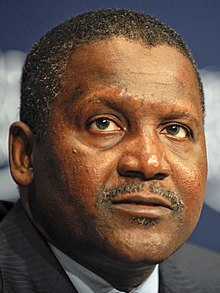Social class in Nigeria


The Bourgeoisie of Nigeria is the bourgeoisie that is native to Nigeria. It has gone through extensive changes over the duration of its long history.
History
Pre-colonial Nigeria
Many chieftaincy sub-systems from the Nigerian region include titled positions for merchants in their structures, and have done so for centuries. An example of this is the Iyaloja title amongst the Yoruba people.[1]
Although the holders of these and other titles would therefore belong more to the Nigerian chieftaincy system than they would to a proper bourgeoisie, their existence in the pre-colonial period nevertheless set the scene for the subsequent development of one. Some bourgeois members of later generations, such as Chief Candido da Rocha, would ultimately be ennobled as members of the said system by way of them.[2]
Colonial Nigeria
Following the abolition of the slave trade by the British, freed slaves were settled by them along the West African coast. The British annexation of Lagos in 1861 and the subsequent promotion of legitimate trade benefited the community of such people in Nigeria, known as the Saro and the Amaro, and they soon became a rising bourgeois through trading with their benefactors thereafter. They were formally educated, utilized a western style of dressing, owned race horses and organized waltzes, square dances and musical soirees where Molière was performed.[3] Mr. R.B. Blaize (a Saro) and the aforementioned Chief Da Rocha (an Amaro) both typified this emergent class.
Outside of this community in particular, other people also engaged in trade on a large scale and joined it in becoming members of what was rapidly coalescing into a national bourgeoisie. Notable amongst them were Alhaji Alhassan Dantata (a member of a hereditary Hausa sub-group whose traditional vocation was trade)[4] and Sir Louis Odumegwu Ojukwu (a member of an Igbo trading family).[5]
Independent Nigeria
At Independence in 1960, members of the Nigerian Bourgeoisie were represented amongst the new leadership that inherited power. For example, Chief Funmilayo Ransome-Kuti (the daughter of a Saro chief that had once traded palm produce) was a member of the Western Region's House of Chiefs.[6]
In the decades since, the Bourgeoisie has expanded further. Links to the political elite have been strengthened, and advantageous policy changes on the part of the politicians have led to the generation of large amounts of wealth by the Bourgeoisie. Notable contemporary members include the dollar billionaires Chief Mike Adenuga (a member of a Yoruba sub-tribe with a reputation for being keen traders), Mrs. Folorunsho Alakija (a member of a family of traders that married into a prominent Amaro clan), and Alhaji Aliko Dangote (a direct descendant of Alhaji Dantata and the richest Black man in the world).[7]
Conspicuous consumption and criticism
Much like the bourgeoisies of other countries, the Bourgeoisie has continued to live in a way that most Nigerians can only imagine; its members have thrown lavish wedding parties, imported their food from abroad, gone on frequent vacations to global hotspots, lived in areas of Nigeria that are amongst the most expensive in the world, and often used their helicopters instead where others are forced to endure traffic for hours.[8] This has led to a significant amount of criticism over the years, most famously that which was offered by the aforementioned Chief Ransome-Kuti, herself a committed socialist. She once wrote:
... The true position of Nigerian women had to be judged from the women who carried babies on their backs and farmed from sunrise to sunset... Not women who used tea, sugar and flour for breakfast.
See also
References
- ^ Sudarkasa, Niara (1973), Where Women Work: A Study of Yoruba Women in the Marketplace and the Home, p. 57.
- ^ "person page". Findagrave.com. Retrieved January 14, 2021.
- ^ Cunha Carneiro da, Marianno; Verger, Pierre (1985). Da senzala ao sobrado: arquitetura brasileira na Nigéria e na República Popular do Benim = From slave quarters to town houses : Brazilian architecture in Nigeria and the People's Republic of Benin. São Paulo: SP: Nobel. p. 34.
- ^ "Meet the wealthy but simple Nigerian merchant behind Dangote's success". Face2FaceAfrica.com. Retrieved January 14, 2021.
- ^ Robert, Sklar (1963). Nigerian Political Parties: Power in an Emergent African Nation. Princeton: Princeton University Press. p. 180.
- ^ "Ransome-Kuti, Funmilayo". Dictionary of African Biography. Vol. 5. Akyeampong and Gates. Oxford: Oxford University Press. 2012. pp. 176–178. ISBN 978-0-19-538207-5. OCLC 706025122.
{{cite book}}: CS1 maint: others (link) - ^ "Dangote, Adenuga, Alakija rank among richest Blacks". Punchng.com. Retrieved January 14, 2021.
- ^ "Crazy Rich Nigerians". Africasacountry.com. Retrieved January 18, 2021.
- ^ Mayer, Adam (2016), "Olufunmilayo Ransome-Kuti", Naija Marxisms: Revolutionary Thought in Nigeria, Pluto Press, pp. 172-176.
